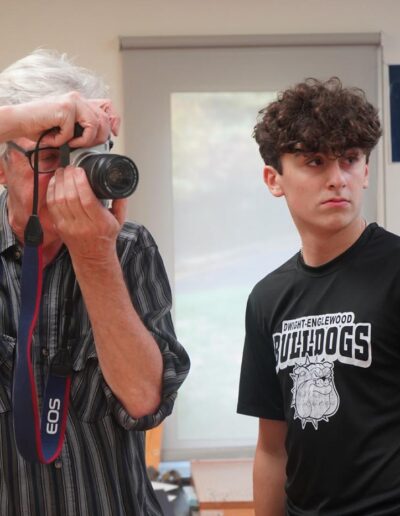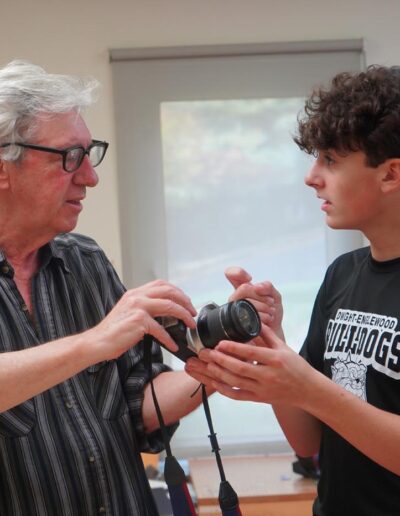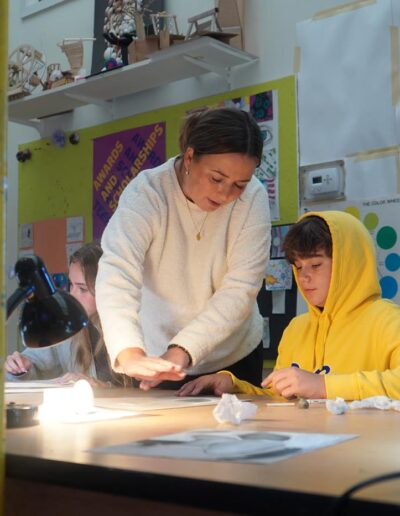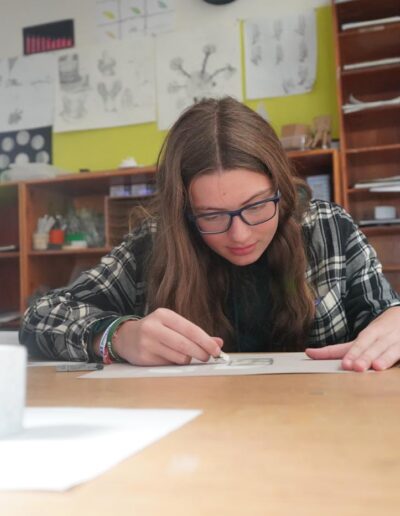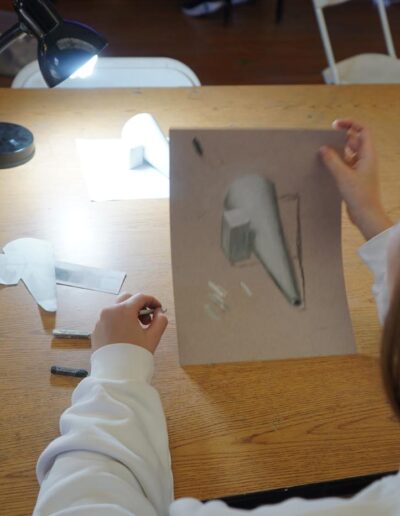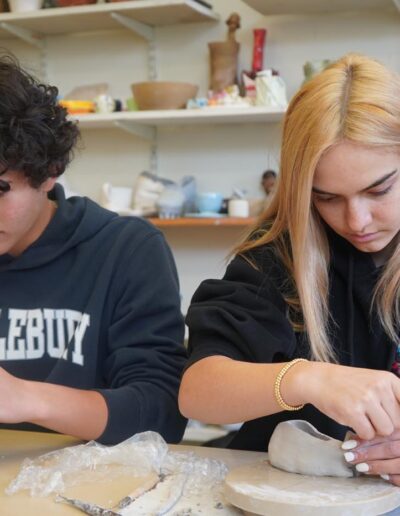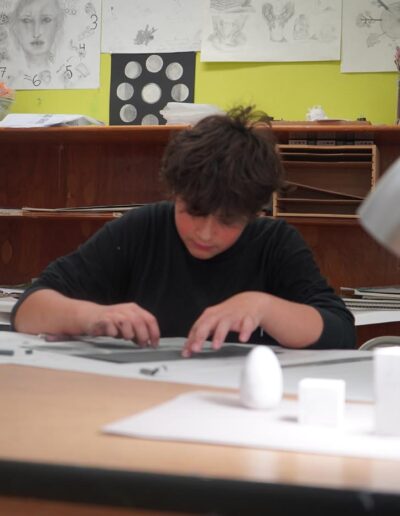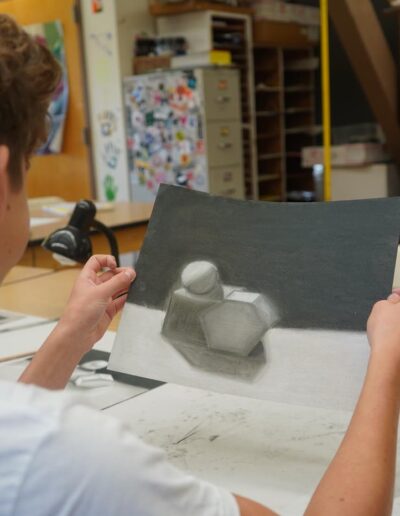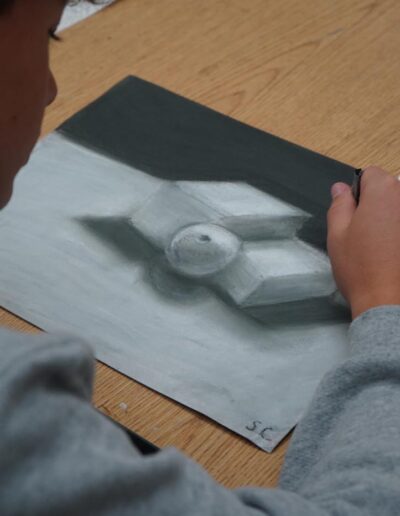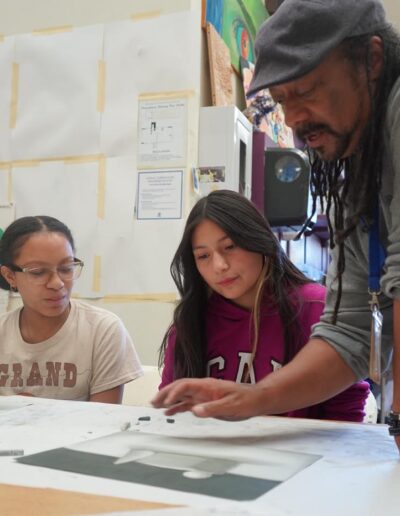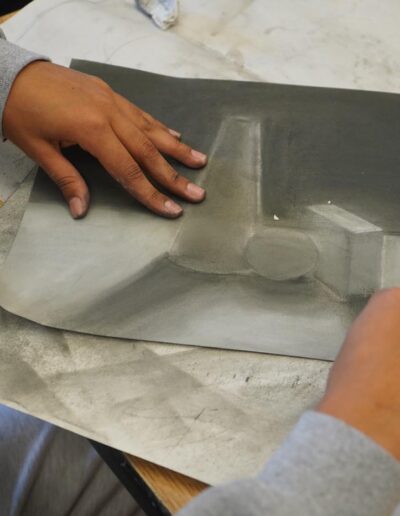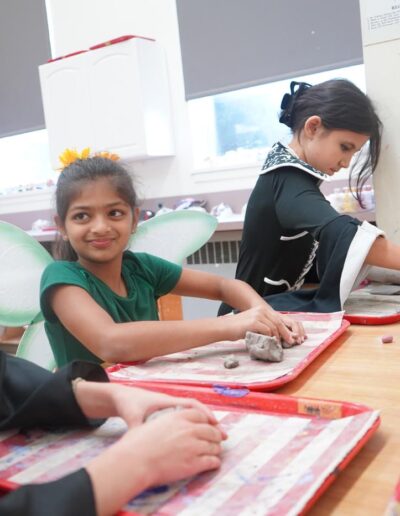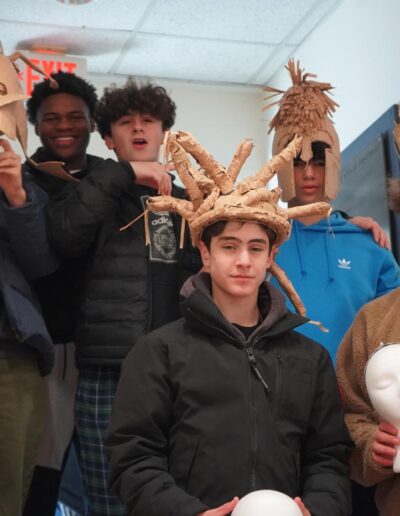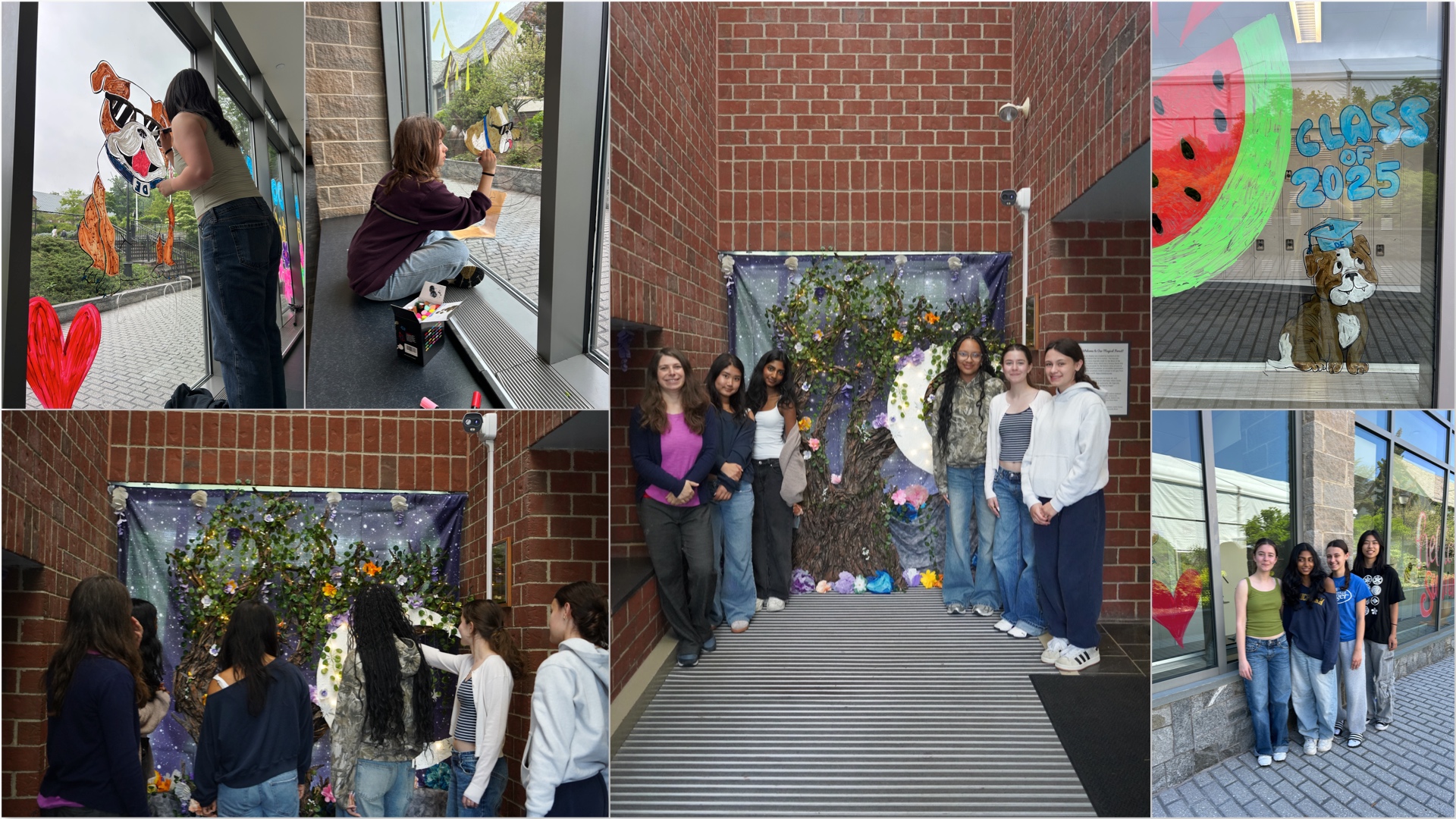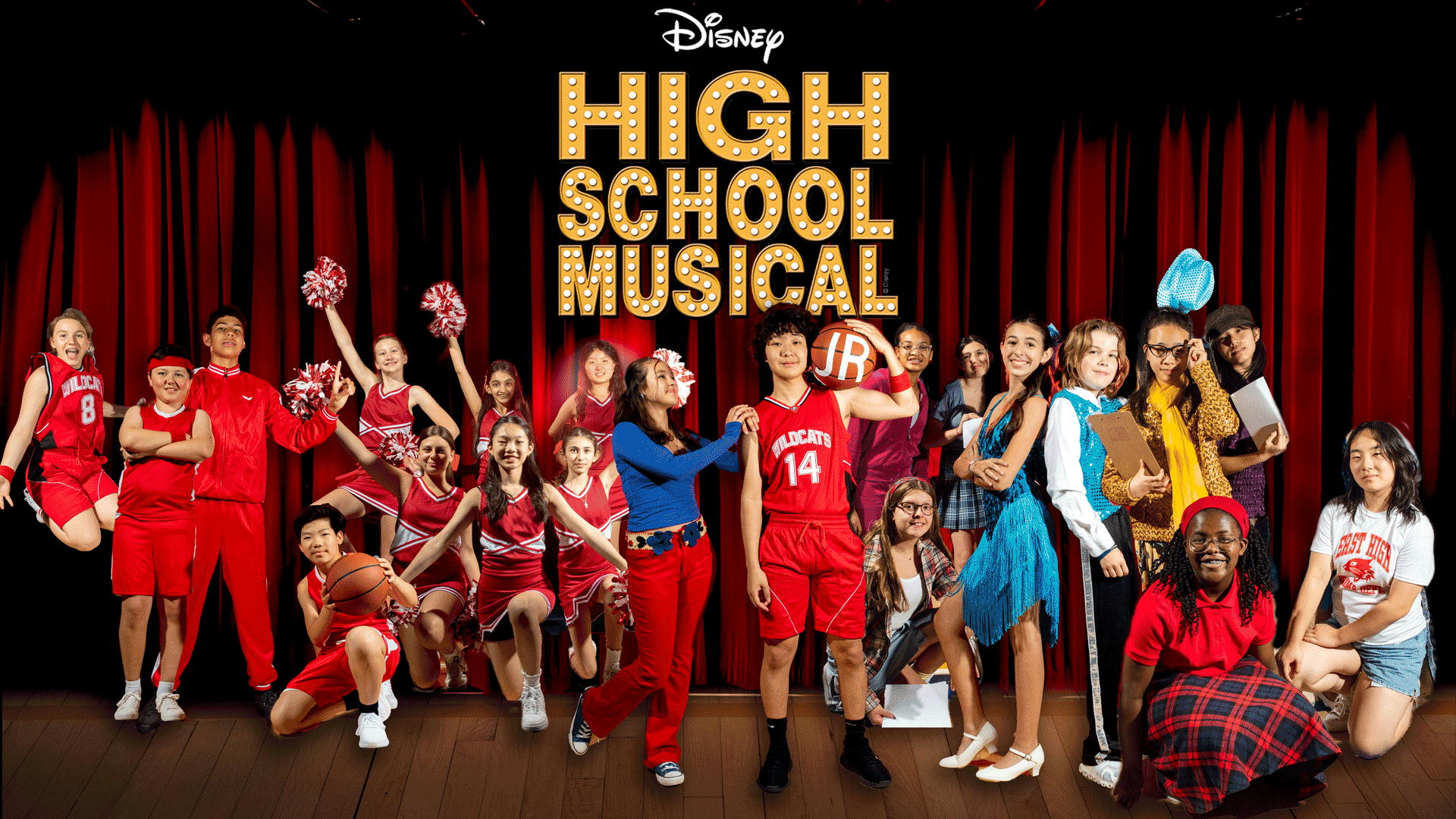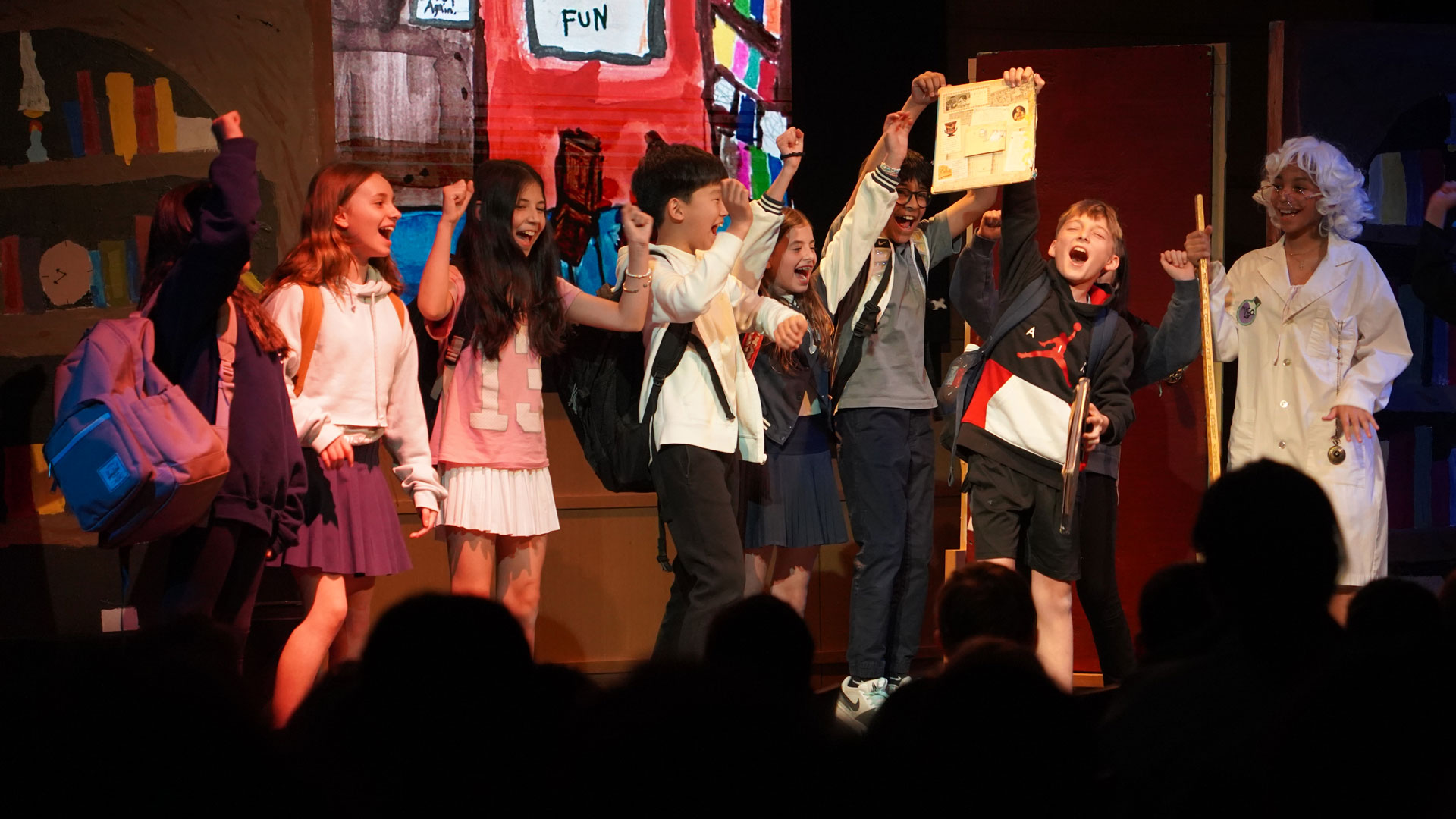Tell us about your career journey and your arrival to D-E.
This is my 26th year at D-E, and I have been the Art & Design Department Chair for the last six years. I attended the HS of Art & Design in NYC. Though I started as an English major, I returned to visual arts, and I received my Bachelor’s in Painting/Sculpture from Antioch College, and I completed my MFA in Painting & Sculpture from the Maryland Institute College of Art. Post graduation, I worked at a lithographic press studio in NYC and then at the Metropolitan Museum of Art. I learned about the opening for an additional 2D/3D art educator position at Dwight-Englewood and I did an ‘audition-lesson’ with a 7th Grade Portrait Drawing class and the rest was history! Since then, I have taught every class in the art department except for photography, Lower School art and many of the new courses added on during my chairship.
How has the Art & Design Department changed over time?
26 years ago, the performing arts, visual arts, & theater departments all shared one chair, and our chair was actually a music educator who knew very little about art education. In the subsequent years, after having the preceding chair be theater-focused, our department fought very hard as a group to get the visual arts separated. It is a common yet unfortunate antiquated model to have the three uniquely positioned and distinct departments joined. It is especially challenging to grow and seek the nuanced and granular growth of art education when your chair is not schooled in the discipline. Music and performing arts can align themselves neatly together, but our studio practice, process, tools, and objectives are completely different. Dwight-Englewood, seeking excellence, championed that notion, and we have been separated now for the last 14 or so years.
Another way we changed, having been trained in computer graphics, 3D printers, and laser cutters; I started the innovative (graphic, industrial, and computer) design program at D-E. There had not been any courses dedicated to art-made for creative services prior to my employment 26 years ago. Commercial art uses a variety of platforms (magazines, websites, apps, television, etc. for which to focus art making). And there were students seeking ways to apply their art skills to graphic areas and beyond such as going into the business of illustration, UI and UX web design.
In my role now as Department Chair for the last six years, I’m especially proud of a few things. The first is having worked to author the language describing the what, how, and why of what we do as art educators in the department. This language and understanding, which includes how we use the eight habits of mind that are involved in studio-based education, has been a way to develop a mission and a vision together as a department.
The second thing I am most proud of is the rebranding of our department with the correct nomenclature for what we do. We are the Art & Design Department. We used to be called the Fine Arts Department. The creation of art for its own sake, or Fine Arts, is primarily not motivated by utilitarianism but rather by aesthetics. When you attach function and form, that’s when you’re in the design and commercial realm. That’s when you’re an illustrator who has the brief to illustrate a story by supplementing the author’s words or creating a vessel that can actually carry water. Design includes ceramics, media studies like video, photo, innovative design, and industrial design. I’m extremely proud of the work we’ve accomplished and how we’ve grown to create a mission for students and faculty to be able to study and practice both Art & Design.
The last thing I am especially proud of is the process of working with my team and the Tech Department (via multiple cameras) to make the impossible task of teaching art during the pandemic and hybrid education possible. I would also add that my team dove deeply into anti-racist art education practices during that same time, and we are all the better educators for those experiences.
What are the foundations of the Art & Design program?
We have four pillars of Art & Design curriculum that persist through the K–12 architecture of our program. The first is Studio Practice, which is actually having hands-on experiential workshop models to learn through doing. We believe a praxis is key to learning. The second pillar is Sketchbook/Documentation. A sketchbook or art journal doesn’t just refer to having an artist sketchbook; it really is about documentation and being able to see your archive, your process, and your progress. Much of the work I’ve done as chair emphasizes the art educators’ nuanced balance between process and product. The learning happens in the process, but viewers experience the final product. However, with the advent of social media, the rich behind-the-scenes process has become more expected. And if AI has shown us anything at all, it is that process will be more important in education than ever before.
The third pillar is Constructive Critique. Sharing artistic intentions and feedback happens in every art class in every division. In AP Studio Art, peer critiques help students see if their techniques are aligned with their intentions or what a young artist can do to improve their objective. At the same time, if you say you love something but can’t explain why, that’s not actually helpful either. Constructive criticism is about deconstructing the pieces of an art piece with analysis and being able to give supportive feedback.
The fourth pillar that runs through our whole K-12 program is Exhibition. The artist’s final product needs to be seen. Whether it’s in the display cases in the hallways, gallery walls, submitted to publications, competitions, or used as a portfolio to supplement college applications, students must be able to ultimately have their work presented. We encourage students to submit to Parnassus, Calliope, Scholastic, and more to do this. Ultimately, it’s about having your work affect the world and be seen in whatever way you can imagine.
These are the four pillars: studio practice (experiential learning), constructive criticism (feedback loop), sketchbook (practice/documentation), and exhibition (publications, displaying work) and it’s something I’m quite proud of.
How does the Art & Design faculty collaborate and co-create a pedagogical philosophy?
We are a phenomenal team. I think what makes us exceptional is that students are learning from working artists: I just completed a mural gig for the Center for Safety and Change, Ms. Scrivanich is a delightful visual artist with both 2D & 3D, Mr. Edwards is a working free-lance graphic designer, Ms. Brusky is a masterful painter, Ms. Young is an incredible watercolorist, as well as, ceramicist; Mr. McCabe has his roots in photojournalism; and our newest member Ms. Christine Hanaway is a creative who makes art education her practice as well as yoga! Being practicing artists and educators creates a wonderful environment to learn from each other and to collaborate. We care deeply that from K-12 representation and diversity are not only seen but experienced throughout our curriculum. We are uniquely equipped for {DEIB} work because our work is enmeshed with an individual’s response and perspective to the world and how it is interpreted. We are inherently positioned to be about reframing, recognizing multiple perspectives, and empathy. When you see a group of students drawing dramatically unique responses from the same still-life you realize how DEIB goes hand-in-hand with how an artist interprets the world and learns to communicate non-verbally with others. We are committed to a holistic anti-racist art educational philosophy.
How does a student progress in Art & Design from early childhood all the way through to Upper School / Grade 12?
Just like with the beginning of civilization, we begin in the Lower School, with the recognition of what is mark-making. As you know, writing your own name is a form of mark making. It’s unique to you as is your own DNA. So what is art? What is an art practice? It’s all of these questions. It’s then the understanding of the differences between shape and form along with the elements of art & the principles of design. If you imagine a bicycle as a sculpture, you can take apart all of its parts. You can do the same with what makes a piece of art—take it apart and you see: line, color, symmetry, focal point, shades, tones and tints, composition etc. A line could be squiggly or curved. It can be expressive, rageful even. So as students reach 5th grade, we’re beginning to discern foreground, middle ground, and background, which are part of the the art element of depth: to create the illusion of dimension within a two-dimensional drawing.
Art education takes the form of a tornado spiral. We revisit the same concepts, like line and color but at different tiers. What happens when we explore color now that we know highlights and shadows of the very same color can help make an object appear dimensional instead of flat? As you go up the spiral, all those fundamentals return with greater complexity.
In the Middle School, we continue the spiral with teaching linear perspective up to three-point perspective. We take a cue from the Renaissance looking how those artists created depth in a composition and how powerful it is in affecting the viewer’s illusion of depth. We also emphasize drawing from life through observation with gesture, figure, and still-life drawings. The shoe-drawing project is a classic example of teaching from life. It’s imperative that students gain the experience of understanding proportion from observation as opposed to always looking at a 2D image or screen and then drawing on yet another 2-dimensional plane.
In the Upper School, the art & design program begins with a foundation year in both 2D and 3D. We then have an array of electives and two art major tracks. I’m proud that Painting & Drawing, Industrial Design, Ceramics, and Accelerated Portfolio Honors each have their advanced level tracks that students can work towards. For example, Accelerated Portfolio feeds into our AP Studio Art course for students who want the challenge of the College Board AP test.
Throughout the Upper School curriculum and all of K-12, we stress Voice & Choice—that students get to discern who and what their artistic voice is. What we want to emphasize is the process of a student recognizing their artistic voice and putting it into practice. Even if a student never goes into the field of being an artist, we firmly believe that an art practice and in knowing how to lose yourself in a state of creative flow can save your life. A creative practice will also help you be a more creative thinker and be able to cross those boundaries. I know that there’s a lot of emphasis on creativity not just being something you do in art, but we really pride ourselves in the fact that it’s something you can develop the ability to do and that art-making can assist you in translating that to other areas of your life. As an art educator for 26 years, I want to say that art education is a vehicle, a fluid moving highway with no bottlenecks, able to arrive at a skill of creativity destination. By making art your brain pattern, and your neurological systems are already boundary-crossing and those connections and liminal spaces birth the ability to think creatively and resourcefully in other situations.
What are your dreams for the future of the department?
Looking towards the future, the things that I would love to see an art & design department able to offer a richer and more nuanced array of electives. Being able to have genres like fibers art, jewelry-making, and stained/ warm glass making would add depth and diversity to our offerings. Additionally, if a student wanted to be a ceramics major and not have to take the AP College Board Exam in order to do a year-long course, that would further enrich our students and their goals. There’s so much that we can expand upon.

![Newspaper-Collage-Art-Effect-[Vertical]](https://d-etoday.org/wp-content/uploads/2023/12/Newspaper-Collage-Art-Effect-Vertical-1.jpg)


